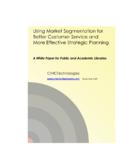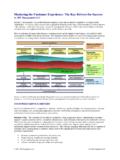Transcription of Best Segmentation Practices and Targeting Procedures that ...
1 best Segmentation Practices and best Segmentation Practices and Targeting Procedures that Provide Targeting Procedures that Provide the most Clientthe most Client--Actionable StrategyActionable StrategyFrank Wyman, Wyman, of Advanced AnalyticsDirector of Advanced AnalyticsM/A/R/CM/A/R/C ResearchResearchSegmentation DefinedSegmentation DefinedSegmentation: The dividing of a market s customers into subgroups in a way that optimizes the firm s ability to profitfrom the fact that customers have different needs, priorities, and economic levers. Keep in mind the end goal of enhancing profitability, as this can help increase the actionability of the Segmentation . At each step ask how can these results help improve profits? best Practice #1 best Practice #1 best Practice #1 Product Positioning Research Product Positioning Research Value AddsValue AddsKey DriversKey DriversChewySweetRichChocolatyHeartyCrun chyPeanuttyLong lastingInexpensiveSaltyLow YieldLow YieldEntry TicketsEntry TicketsDerived ImportanceLowHighPerformanceWell Above CompetitorsSlightly AboveSlightly BelowWell Below CompetitorsLowHighStated ImportanceConduct product positioning research around the same time as Segmentation to improve the interpretability and enhance the actionability of the Practice #2 best Practice #2 best Practice #2 Three basic approaches Three basic approaches to Segmentation to Segmentation Analytic Analytic SegmentationSegmentationInterdependenceI nterdependence(clustering)(clustering)De pendenceDependence(CHAID)(CHAID)NonNon-- Analytic Analytic (convenience)
2 (convenience) SegmentationSegmentationSegmentationSegm entationThree basic approaches Three basic approaches to Segmentation to Segmentation Analytic Analytic SegmentationSegmentationInterdependenceI nterdependence(clustering)(clustering)De pendenceDependence(CHAID)(CHAID)NonNon-- Analytic Analytic (convenience) (convenience) SegmentationSegmentationSegmentationSegm entationChoose to take an analytic approach to Practice #3 best Practice #3 best Practice #3 Three basic approaches Three basic approaches to Segmentation to Segmentation Analytic Analytic SegmentationSegmentationInterdependenceI nterdependence(clustering)(clustering)De pendenceDependence(CHAID)(CHAID)NonNon-- Analytic Analytic (convenience) (convenience) SegmentationSegmentationSegmentationSegm entationBest Practice #4 best Practice #4 best Practice #4 Strategy => Interdependence (clustering) Tactics => Dependence (CHAID)Considerations in deciding between an Considerations in deciding between an interdependence or dependence interdependence or dependence approach, or bothapproach, or both Is a primary objective to know the entire market (what are the needs of customers, how many needs groups exist, and how large is each)?
3 Is a primary objective to know how to target those who will buy my offering/product/service ? How old is the market? To what degree are customer needs being met? How old is your product (existing, new launch, line extension)? How crowded is the market? How much room for differentiation is there? How dynamic is the market (how much has the market changed since your last Segmentation )? best Practice #5 best Practice #5 best Practice #5 Let the parameters of your market and product offering determine which of the 2 analytic approaches to general taxonomy of analytical A general taxonomy of analytical Segmentation methodssegmentation methodsAnalytic SegmentationAnalytic SegmentationInterdependenceInterdependen ceDependenceDependenceClusteringClusteri ngQQ--FactorFactorAnalysisAnalysisTreein gTreeingNeuralNeuralNetworkNetworkHierar chicalHierarchicalKK--meansmeans22--step stepLatent ClassLatent ClassC&RTC&RTCHAIDCHAIDQ uestQuestA general taxonomy of analytical A general taxonomy of analytical Segmentation methodssegmentation methodsAnalytic SegmentationAnalytic
4 SegmentationInterdependenceInterdependen ceDependenceDependenceClusteringClusteri ngDistancesDistancesQQ--FactorFactorAnal ysisAnalysisTreeingTreeingNeuralNeuralNe tworkNetworkHierarchicalHierarchicalKK-- meansmeans22--stepstepLatent ClassLatent ClassC&RTC&RTCHAIDCHAIDQ uestQuestBest Practice #6 best Practice #6 best Practice #6 Friends don t let friends use Q-factor analysis and Neural net for Segmentation !A general taxonomy of analytical A general taxonomy of analytical Segmentation methodssegmentation methodsAnalytic SegmentationAnalytic SegmentationInterdependenceInterdependen ceDependenceDependenceClusteringClusteri ngQQ--FactorFactorAnalysisAnalysisTreein gTreeingNeuralNeuralNetworkNetworkHierar chicalHierarchicalKK--meansmeans22--step stepLatent ClassLatent ClassC&RTC&RTCHAIDCHAIDQ uestQuestBest Practice #7 best Practice #7 best Practice #7 best all-around approaches are k-means clustering (for interdependence) and CHAID (for dependence).
5 Objectives of the 2 analytic Objectives of the 2 analytic approaches to segmentationapproaches to Segmentation Interdependence (clustering) What are the existing camps of needs among consumers? 1. How many segments ( natural camps ) are there?2. How is each defined needs/beliefs/behaviors?3. What is the size of each segment?4. What are the markers of each segment?5. Given their needs and my product s features, which segments are good targets ? Dependence (CHAID) Who will buy my product and who will not? many segments are there with distinctly different propensities toward buying my product? are the key drivers that define the segments who will buy (and not buy) my product? do I best reach those most likely to buy my offering? propensities and sizes, which segments are good targets?Data Considerations for Data Considerations for Segmentation in GeneralSegmentation in General Sample size: 400-600 minimum; 1000+ typical.
6 Figure that a 5% segment can hold promise and that you do not want to make inferences from subgroup (segment) sample sizes of less than 30 ..thus, 30/5% = 600minimum. Representative (random) sample; no Practice #8 best Practice #8 best Practice #8 For analytic Segmentation , gather a large (600+), random Considerations Questionnaire Considerations for Segmentation in Generalfor Segmentation in General Include (towards end) lots of demographics, as well as media and channel use items Include at least some competitive product usage and perceived performance items best Practice #9 best Practice #9 best Practice #9 Questionnaire should include lots of demographics, media use, and channel use items so that you can discern how to best reach target segments. Also, including at least some items regarding competitive product use and perceived performance is a good Considerations for Data Considerations for ClusteringClustering Preceded by good qualitative work (focus groups) in order to have solid knowledge of all the needs dimensions currently in effect in the market Shorter scale (5-point) better than longer (11-point) since, Battery may/should be long Helps avoid differential scale use Place distinctanchors (labels) on each point of scale to help avoid differential scale use, , 1 totally agree, 2 somewhat agree, 3 neutral, 4 somewhat disagree, 5 totally disagree Needs statements/questions should themselves be extreme.
7 A types are better than like my candy to be extremely crunchy..I absolutely love like my candy to be crunchy..I like Practice #10 best Practice #10 best Practice #10 Precede interdependence (clustering) Segmentation with fresh qualitative research(focus groups). best Practice #11 best Practice #11 best Practice #11 Slay differential scale use! Avoid this evil bias by designing a needs battery based on a short (1-5 agree-disagree) scale with clearly differentiated anchors on every point and items worded in the extreme. best Practice #12 best Practice #12 best Practice #12 Consider using conjoint-or discrete-choice-based utilities as the basis of Cleansing for ClusteringData Cleansing for Clustering Biggest problem in clustering is differential scale use (response style bias). Test for differential scale use via clustering 2 segments.
8 If, across attributes, the 2 profiles are strongly correlated and different only in general level of response, then a differential scale use problem exists in the data and needs to be Cleansing for ClusteringData Cleansing for Clustering12345 CrunchySweetChocolateyPeanuttyRichChewyN eed LevelSegment 1 Segment2 Data Cleansing for ClusteringData Cleansing for Clustering12345 CrunchySweetChocolateyPeanuttyRichChewyN eed LevelSegment 1 Segment2 best Practice #13 best Practice #13 best Practice #13 Before clustering in earnest, always first test for response style (differential scale use) bias by examining the parallel-ness of profiles for 2-3 Cleansing for ClusteringData Cleansing for Clustering Semi and full ipsatization (re-centering and re-dispersing) Outliers (ok leave them in) Missing data presents a problem so fill in. Use mean of other attributes for the respondent adjusted by a sample-wide factor for that attribute.
9 Or if only a few missing data points then just throw out cases via listwise deletion. Will need to standardize ( Z scores) if basis variables arise from different scales (why I strongly urge just one single same-scaled needs battery) best Practice #14 best Practice #14 best Practice #14If differential scale use (response style) bias exists, then fix it via ipsatization! best Practice #15 best Practice #15 best Practice #15 When clustering data, outliers are OK (leave em alone) missings are not(fill em in).Precede Clustering Analysis with Precede Clustering Analysis with Factor AnalysisFactor AnalysisOriginal itemFactor 1 Factor 2 Factor 3 Factor 4 Crunchy+Sweet+Chocolaty+Peanutty+Rich+Ch ewy+ best Practice #16 best Practice #16 best Practice #16 Cluster only unique dimensions; factor analyze original items to get the unique dimensions. Data Analysis in ClusteringData Analysis in the best number of cluster segments: Via k-means, examine the decomposition of segment sizes in higher and higher order solutions (2-12); crosstab prior-run results with next higher-order solution.
10 Stop once the larger segments stabilize and/or new segments pull from too manyprior segments and/or some segments begin to substantially growin size, then a too many segments point has been reached. Use hierarchical (dendrograms), latent class, and two-step cluster analysis to help determine final answer for # of segments. Client final cluster solution via two runs of k-means: Use first pass results (centroids) as starting points for 2nd, final k-means of basis variable means across segments, while opportunistic, gives a basic sense of how much differentiation exists between final Practice #17 best Practice #17 best Practice #17In clustering, use numerous algorithms to solidify answer to How many segments? Once the number is decided, obtain final cluster segments using a two-step k-means process. Data Considerations for CHAIDData Considerations for CHAID Stated purchase intent Exaggeration-corrected, derived purchase intent (Assessor ) Conjoint/choice derived May be something different than purchase intent.




